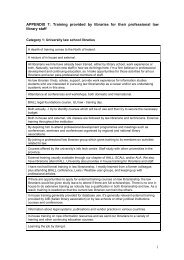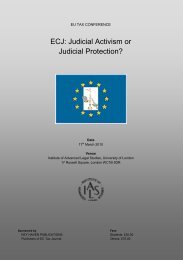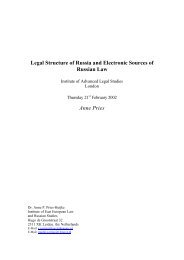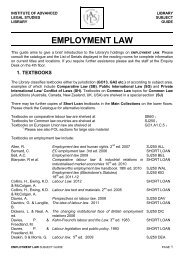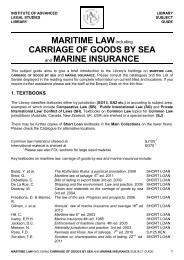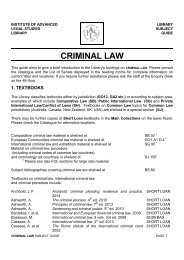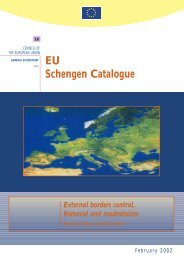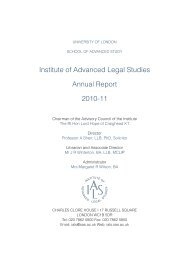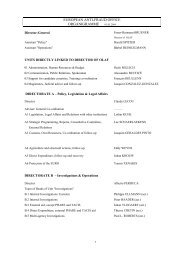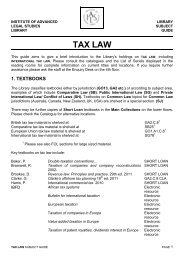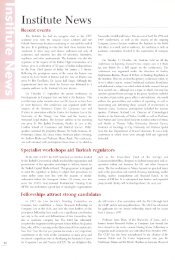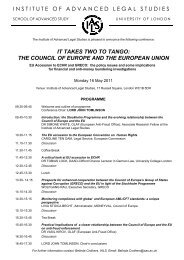a thesis - Institute of Advanced Legal Studies
a thesis - Institute of Advanced Legal Studies
a thesis - Institute of Advanced Legal Studies
You also want an ePaper? Increase the reach of your titles
YUMPU automatically turns print PDFs into web optimized ePapers that Google loves.
114 IMPLIED TRUSTS.<br />
the authority <strong>of</strong> A. or B., D. draws a cheque on the trust account<br />
for the amount, X. and Y. apply the cheque in discharge <strong>of</strong> the<br />
bill. They know that the 7701. is trust money. X. and T. must<br />
repay the 750/. to the trust account. Bridgman v. Gill (1857),<br />
24 Beav. 302.<br />
3. A. and B., trustees, employ X., a solicitor, to receive the proceeds<br />
<strong>of</strong> part <strong>of</strong> the trust estate from a purchaser. X. pays the<br />
money to A. alone, without B.'s authority or receipt. A. misappropriates<br />
it and dies insolvent. X. is a constructive trustee, and<br />
must make good the loss to the trust estate. Lee v. Sankey (1872),<br />
L. E. 15 Eq. 204.<br />
B.— Cases in which Agent held not liable as Trustee.<br />
1. A. and B., trustees, employ X. and Y., bankers, to collect<br />
assets forming part <strong>of</strong> the trust fund. X. and Y. receive the assets<br />
and apply them in payment <strong>of</strong> bills drawn on them by A. and B.<br />
In drawing the bills A. and B. in fact commit a breach <strong>of</strong> trust,<br />
but X. and Y. are unaware <strong>of</strong> this. X. and Y. are not liable as<br />
constructive trustees. Ream v. Robarts (1819), 4 Madd. 332.<br />
2. A., a sole surviving trustee, desires to retire and appoint B.<br />
in his place. He instructs X., a solicitor, to prepare the necessary<br />
documents. X. advises A. against appointing B. as sole trustee,<br />
but A. insists, and X. prepares a deed <strong>of</strong> appointment <strong>of</strong> B. as sole<br />
trustee and a deed <strong>of</strong> indemnity. Y., another solicitor, approves<br />
the deeds on behalf <strong>of</strong> C., the ccstni que trust, after having pointed<br />
out to 0. the risk <strong>of</strong> loss <strong>of</strong> the trust fund, and obtained C.'s<br />
express instructions to carry out the arrangement. B. misappropriates<br />
the trust fund. Neither X. nor Y. ever has control <strong>of</strong> the<br />
trust fund, nor have they any apprehension <strong>of</strong> any fraudulent<br />
design on the part <strong>of</strong> A. or B. Neither X. nor Y. is liable as a<br />
constructive trustee. Barnes v. Addy (1874), L. E. 9 Ch. 244.<br />
3. A. is a sole trustee. It is arranged that A. shall not be<br />
entitled to draw on the trust account at the bank without the concurrence<br />
<strong>of</strong> B. and 0., who are to initial her cheques. A. draws<br />
and B. and 0. initial cheques on the account, for purposes which,<br />
as B. and C. are aware, are a breach <strong>of</strong> the trust. B. and 0. do<br />
not thereby become constructive trustees. In re Barney, (1892)<br />
2 Ch. 265.



